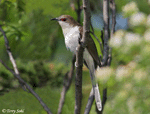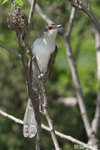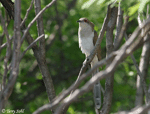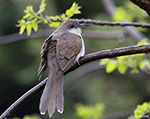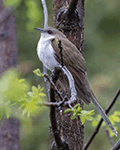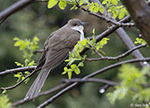Black-billed Cuckoo
Coccyzus erythropthalmus
| Length: 11 to 12 inches | Wingspan: 15 to 17 inches | Seasonality: Summer |
| ID Keys: Brownish upperparts, white underparts, black bill, narrow red eye-ring. | ||
 The Black-billed Cuckoo is
most often found in dense deciduous woodlands and thickets, and is more often
heard than seen. Populations often fall and rise in conjunction with
caterpillar populations, especially hairy tent caterpillars. The young of
a Black-billed Cuckoo become mobile rather quickly after hatching, and may
clamber out of the nest within a week of being born. When
discovered, the young will sometimes "freeze" with their
neck stretched and bill in an upright position, somewhat similar to how an American
Bittern "hides".
The Black-billed Cuckoo is
most often found in dense deciduous woodlands and thickets, and is more often
heard than seen. Populations often fall and rise in conjunction with
caterpillar populations, especially hairy tent caterpillars. The young of
a Black-billed Cuckoo become mobile rather quickly after hatching, and may
clamber out of the nest within a week of being born. When
discovered, the young will sometimes "freeze" with their
neck stretched and bill in an upright position, somewhat similar to how an American
Bittern "hides".
In South Dakota Black-billed Cuckoos are found throughout the state in suitable habitat. They are most often found in dense woodlands and riparian areas, but may occasionally be found in (large) farmstead shelterbelts or other woodland areas.
Habitat:
Primarily found in deciduous forests. This may include forest interiors, woodland edges, riparian areas, marshland edges, and shrubby second-growth forest.
Diet:
Heavily dependent upon caterpillars, although they will also feed on other insects as available. They tend to feed on large insects such as caterpillars, grasshoppers, crickets, cicadas, and beetles. Black-billed Cuckoos will also occasionally eat small fruits and berries, bird eggs, snails, and small fish.
Behavior:
Climbs, flits, and hops in the foliage of trees and bushes, gleaning insects from foliage and branches as it moves.
Nesting:
June and July. The nest of a Black-billed Cuckoo is a poorly constructed platform of twigs, with a lining of fine grasses, leaves, mosses, and other vegetative material depending upon local habitat. It is usually placed relatively close to the ground in a well protected location, such as in a thicket, low in a tree near extensive forest undergrowth, or similar protected area. Both sexes help to the build the nest, and both parents help to incubate the 2 to 5 eggs laid by the female. The young hatch after 12-14 days. The young become mobile rather quickly, often leaving the nest within a week of hatching, but staying close to it until they gain the ability of flight. Note like other cuckoo species, Black-billed Cuckoos will also sometimes lay their eggs in the nests of other birds.
Interactive eBird Map:
Click to access an interactive eBird map of Black-billed Cuckoo sightings
Song:
Repeated po po po, also a rolling call beginning very rapidly and slowing towards the end.
1Click here to hear the po po po song of a Black-billed Cuckoo, recorded in Hampshire County, Massachusetts.
2Click here to hear theh rolling call of a Black-billed Cuckoo, recorded in Passic County, New Jersey.
Migration:
Summers throughout the Great Plains, the Midwest, the Northeastern U.S., the Appalachians, and southern Canada. Winters in South America.
South Dakota "Hotspot":
A rather unpredictable species, present in good numbers in a location one year, and absent the next. These movements are thought to be due to availability of their favorite food, caterpillars. However, there are some areas where you are more likely to come across Black-billed Cuckoos. Newton Hills State Park has by far been the best location for me for sighting the species, and I have also seen them on multiple occasions at the Big Sioux Recreation Area.
Similar Species:
In South Dakota, there's one additional cuckoo species that could be confused with Black-billed Cuckoo, while elsewhere, other cuckoo species may be present in the same general location as a Black-billed Cuckoo:
- Yellow-billed Cuckoo - Both species are found in South Dakota, and both may inhabit the same habitat. Voice differences distinguish the two if the birds are heard but not seen, and plumage and other differences makes them easy to differentiate if seen well. The namesake bill color for each species is diagnostic, with the Black-billed Cuckoo having a thinner black bill, while the Yellow-billed Cuckoo has a more robust yellow bill. Both species have brownish upperparts, although the Yellow-billed Cuckoo may appear to be "warmer" in coloring. Yellow-billed Cuckoos have an extensive, warm rusty color on the wings (best seen if wings are partially extended), which is less extensive or visible on a Black-billed Cuckoo. Tail differences are also obvious, with large white spots on a Yellow-billed Cuckoo and a much plainer tail on a Black-billed Cuckoo. Finally, Black-billed Cuckoos have an obvious red eye ring that Yellow-billed Cuckoos lack.
- Mangrove Cuckoo - Not an identification concern in South Dakota, or in most areas for that matter, as Mangrove Cuckoos are confined to the Caribbean, far southern Florida, or near coastlines of Mexico and Central America. Habitat preferences are also obvious, given the name of the Mangrove Cuckoo. However, the two could potentially cross paths in Mexico or the Caribbean during migration of the Black-billed Cuckoo. If seen well, plumage and color differences make differentiating the species simple. Black-billed Cuckoos have a solid black bill, while that of a Mangrove Cuckoo is two-toned, with a yellow bottom and black top bill. Mangrove Cuckoos are dark above with a warm rusty tint on their underside, while Black-billed Cuckoos are white underneath. Black billed cuckoos have dark tails with white feather tips, while Mangrove Cuckoos have much more extensive white on the tail.
Conservation Status:
Populations rise and fall with availability of caterpillars for forage. Overall populations have undergone a decline in recent decades, as measured by counts such as Breeding Bird Survey. Reasons for the decline are not clear, but contributing factors likely include 1) habitat loss, on both their summer breeding grounds and wintering grounds, 2) pesticide use which lessens caterpillar populations and may poison birds that feed on sprayed insect populations, and 3) climate change. Regarding the latter point, an issue potentially facing many birds is something called "phenological mismatch". With changing weather patterns, emergence of caterpillars may occur earlier than historic timing, with fewer caterpillars available during the crucial nesting period. Because of the significant decline in populations since the mid 20th century, Partners in Flight have Black-billed Cuckoos on their "Yellow Watch List". However, they are still found over a very broad geographic area and are somewhat common in parts of their range. The IUCN thus considers the Black-billed Cuckoo to currently be a species of "Least Concern".
Further Information:
1) BirdWeb - Black-billed Cuckoo
2) WhatBird - Black-billed Cuckoo
3) Audubon Guide - Black-billed Cuckoo
Photo Information:
May 19th, 2019 - Newton Hills State Park - Terry Sohl
Additional Photos:
Click on the image chips or text links below for additional, higher-resolution Black-billed Cuckoo photos.
Audio File Credits:
1Andrew Spencer, XC21096. Accessible at www.xeno-canto.org/21096
2Dan Lane, XC215998. Accessible at www.xeno-canto.org/215998
| Click on the map below for a higher-resolution view |
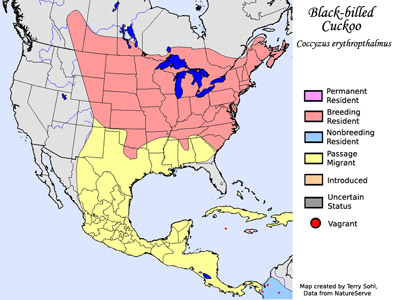 |
| South Dakota Status: Uncommon migrant, and summer breeding resident. |
Additional Black-billed Cuckoo Photos
Click for a higher-resolution version of these photos
